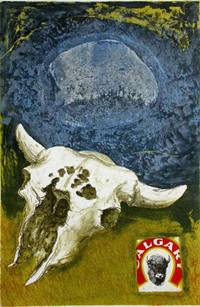Evans' Sunshine
Sunshine 56 x 76 cm waterless lithograph printed in 14 colors from 9 plates in 1994. Background reverse of a toner wash
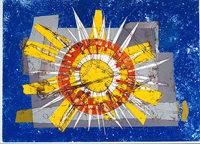

A Flower for Sidney
A Flower for Sidney. 56 x 76 cm waterless printed in 13 colors from 11 plates in 1998. Interference pigments applied in 3 areas.
A 76 x 56 cm waterless lithograph printed in 1996 using my linear offset for the first time. Two HC negatives were exposed through the 4 x 5 enlarger from plastic pieces mounted to glass. Kwik Proof material was used for exposure from one of the negatives to produce images for registration of the other colors. Flats were drawn with Sumi ink and textures made with toner washes. Eight color edition printed from 7 plates
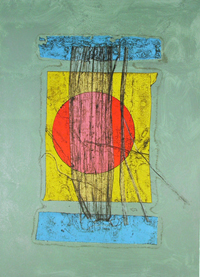

Blueprint for a Henge
A 66 x 51 cm waterless lithograph printed on Daniel Smith Lenox paper in 2005. The image was produced with pieces of clear plastic on Mylar and scanned into a computer, where it was manipulated in Photoshop. Two transparencies were printed out with different density of color - one for brown and an thinner line for black; both exposed to Dupont positive plates. Flats made with red paper on Mylar and exposed to my own positive plates. Nine colors from 7 plate
Sun Medal
A 66 x 51 cm waterless lithography printed in 1994 on Rives BFK. Original birefringment
image was produced on glass for enlargement unto HC negatives and subsequent exposure to diazo wipe-on plates. These were used to print the two line components of the image, while other plates where coated with Kwik Proof for registration of flats and toner washes. Eleven colors were printed from 6 plates using various ways of manipulating the printed plates

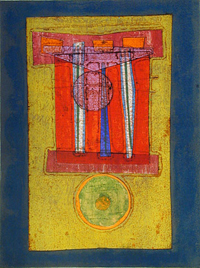
Medal for Zackery
A 66 x 51 cm waterless lithograph printed in 24 colors from 24 plates in 1998. Original image produced on a 4 x 5 inch glass sheet with clear plastics. Textures to unsiliconed areas with water soluble materials, Omnichrom pencils and toner. Flats were made on my own positive plates using red paper cutout adhered to Mylar. Most colors printed by linear offset, others by direct plate transfer of ink
Insight
A 56 x 76 cm waterless lithograph printed in 14 colors from 13 plates. Image made up of plastic shapes adhered to 4 x 5 inch Mylar and exposed to HC negatives.Printed in 2000
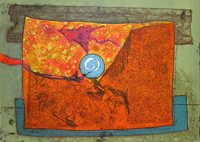

The Atlantis Dig
56 x 76 cm waterless lithograph printed in 17 colors from 14 plates in 2000 on my linear offset press conversion
38 x 56 cm waterless lithograph printed by direct transfer on Arches 88. One of the images for the HK collaboration. The horse images were drawn on newsprint with toner chalks and transferred to plates using the ghost image for adding more toner and details. The background was a toner wash on Mylar using the multi transfer technique by transferring to many plates


The Two Medals
A 38 x 56 cm waterless lithograph printed in 16 colors. Images created with plastics and scanned into computer to produce transparencies. Flats printed by linear offset on a small press I built while line images directly from plate on my large litho press. Gaudy colors are picked to make a political statement about unwarranted decorations to undeserving
Medal for Benjamin
A 66 x 51 cm waterless lithograph printed in 14 colors from 8 plates. The 4 x 5 inch birefringement “plate” of glass was exposed unto 2 HC line negatives with slightly different times. Eight plates were exposed to Kwik-Proof for registration of colored image made with toner and Sumi ink. Interference pigments were dusted through masks on some freshly printed areas. Printed in 1994.
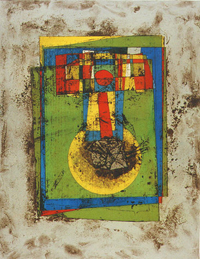
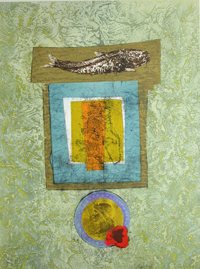
Medal for a Fossil Hunter
A 70 x 50 cm waterless lithograph printed in 2004 in 19 colors. Flats printed with linear offset and fine detail by direct method. The image is made up of scanned images on transparent plastics and assembled unto a larger sheet of Mylar, than exposed to my own positive plates. Background is a toner wash on Mylar transferred to four plates but I chose to not use one to leave white space. Fish is scan of an actual fossil that was added to the image. Head on medal is photograph of a medal that was manipulated in Photoshop
Shrine for Astarte
A 66 x 51 cm waterless lithograph printed in 2005 on Daniel Smith Lenox paper. Image was made from clear plastics mounted to Mylar and scanned into a computer. File was printed out on a HP wide format 110 plus inkjet printer using pigmented ink. Key image printed out unto Dupont commercial positive plate and the flats on Mylar to my emulsion coated positive plates. Eleven colors from 10 plates
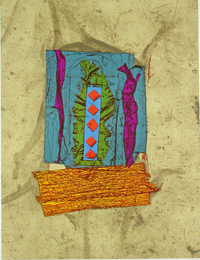
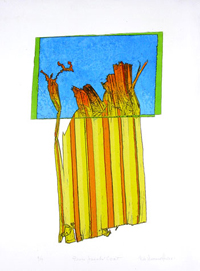
From Jacob's Coat
A 28 x 51 cm waterless lithograph printed in 13
colors from 10 plates on my linear offset conversion to a transfer press. Original was a birefringment
image taken from a 35 mm slide I used in my painting classes in early 60’s. Slide was scanned and a large transparency printed out on an Epson 3000 inkjet printer for exposure to my own positive plates. A set of embossing dies were made from cutout heavy matte board that was hardened with epoxy resin after shapes defined. The embossing was done on the litho press.
Coat-of-Arms
Waterless lithograph printed on 76 x 56 cm paper in 11 colors from 10 plates. The original image was made glass using plastic tapes and other clear materials. This 4 x 5 inch image was exposed unto HC negatives with a darkroom enlarger. The negatives were used on two diazo wipe-on plates to print black and brown line images. Other plates used were reclaimed from other editions with fluoride stripping solution and flats were put on with Sumi ink and toner washes. Printed in 1997
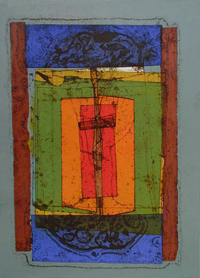
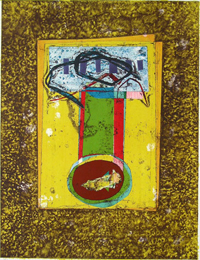
Medal on Yellow
A 61 x 47 cm waterless lithograph printed on Exeter rag paper. Original image produced on 4 x 5 inch piece of glass with clear plastics and exposed unto HC negatives with two different times. The negatives were used for exposure to diazo wipe-on plates to produce the line part of the image. Toner washes and flats were printed from recycled plates. Six colors printed from 6 plates in 1992.
A 76 x 56 cm waterless lithograph printed by linear offset in 22 colors from 8 plates. Reduction techniques used to print the edition. Medal images scanned to computer and manipulated in Photoshop and printed out on a Lexmark inkjet at 1200 dpi. The flag image was scanned and printed out on a Xerox laser printer at 600 dpi. Textural images within the medals scanned and printed on the Lexmark at 1200 dpi. Lettering was Letraset letters put on Mylar and exposed to my positive plates as were all the other transparencies. The red ribbon was interwoven through the sheet cut at the point where the image is separated from the background.
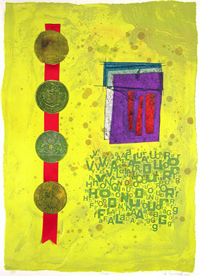
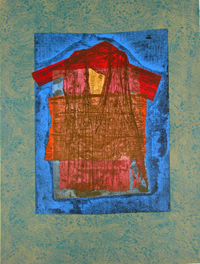
Musashi's Zen Robe
A 66 x 51 cm waterless lithograph printed on Daniel Smith Lenox paper in 2005. Image produced from clear plastics mounted to File printed out on a HP wide format inkjet printer using pigmented ink and exposed to Dupont positive plate. Transparencies for flats mad with red paper and Mylar exposed to my emulsion coated positive plates.Toner wash on Mylar was close cut to image and transferred to a recycled plate. Brown background printed by linear offset and toner wash by direct plate/paper contact. Eleven colors from 11 plates
A 66 x 51 cm waterless lithograph printed on Daniel Smith Lenox paper in 2005. The image used clear plastic mounted to Mylar and scanned into a computer. The main image printed out on a HP wide format 110 plus inkjet printer and exposed to Dupont positive plate. Flats made by using red paper on Mylar and exposed to my positive plates using screen emulsion.
Nine colors from 7 plates
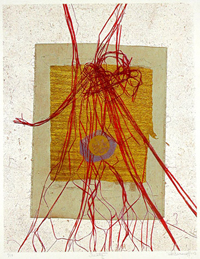

Splotch
A 66 x 51 cm waterless lithography printed in 12 colors from 10 plates. Image made up of cut clear plastics mounted on Mylar and scanned into a computer for manipulation in Photoshop. A line transparency was made with a HP wide format inkjet using pigmented black ink. Flats cut from red paper on Mylar and exposed to my own positive plates. Image of eagle scanned from Dover copyright free publication. Stars are small plastic one used for throwing at weddings that were glued to a sheet of Mylar. Background blue was printed by linear offset, all other colors by direct methods
A 66 x 51 cm waterless lithograph printed on Rising Mirage paper in 1996. The original was a simple clear plastic adhered to a 4 x 5 sheet of Mylar, then exposed to HC negatives. These were exposed to diazo wipe-on and Kwik Proof sensitized plates. Toner washes used to add textures and Sumi ink for flats. The 7 iridescent pigments were added to wet ink through cutout areas of a paper mask. Thirteen colors applied from 4 basic plates.
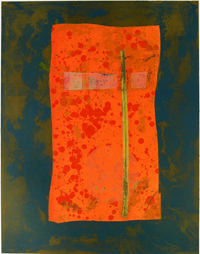
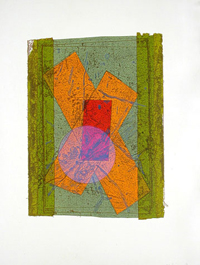
The Meaning of Life
A 66 x 51 cm waterless lithograph printed on Daniel Smith Lenox paper in 2005. The image was produced with pieces of clear plastic on Mylar and scanned into a computer, where it was manipulated in Photoshop. Two transparencies were printed out with different density of color - one for brown and an thinner line for black; both exposed to Dupont positive plates. Flats made with red paper on Mylar and exposed to my own positive plates. Nine colors from 7 plates
A 66 x 51 cm waterless lithograph printed on Daniel Smith Lenox paper in 2003. There are 14 colors from 12 recycled plates. Original image is made up of clear plastic pieces mounted to a sheet of Mylar and scanned to a computer where it was manipulated in Photoshop CS. Transparency was printed out on HP 110 plus wide format inkjet printer using pigmented ink. The transparency and flats exposed to my own positive plates. All plates printed directly to paper
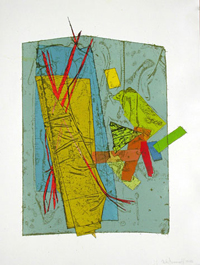
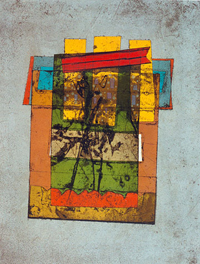
Iskubus
A 66 x 51 cm waterless lithograph printed on Rives BFK in 1994. Original image made on 4 x 5 glass with various clear plastics and projected unto HC negatives with two different exposures for use as the line component of the image. The textures were made with toner washes and flats with waterbased glue. Printed in 9 colors from 8 plates with 3 interference pigments added to different areas.
A 66 x 51 cm waterless lithograph printed on Rising Mirage rag paper in 1996. The original image was on a 4 x 5 inch sheet of glass with various clear plastics adhered to it. The original was exposed unto HC negatives with an enlarger and the negatives used to make two diazo wipe-on plates to print black and brown line images. Kwik Proof applied to recycled plates were exposed to one of the negatives and used to register the remaining 8 colored plates. Toner and Sumi ink used for textures and flats.
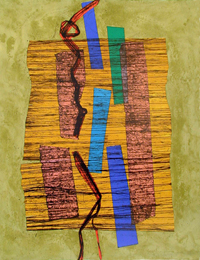
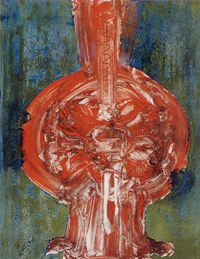
Gift of Prometheus
A 66 x 51 cm waterless lithograph printed on Arches paper in 1995. Toner wash on Mylar was transferred in stages unto two plates to print red and black. Background is a reverse toner wash printed in green and blue.A 66 x 51 cm waterless lithograph printed in 21 colors from 21 plates. Two HC line negatives were exposed from the image made up of plastic shapes adhered to a 4 x 5 inch sheet of Mylar. Printed by my linear offset method from plates using toner washes on Mylar and red paper cutouts for flats. Positive plates were made using my own formula.
Five iridescent pigments add to fresh ink through cut out masks.

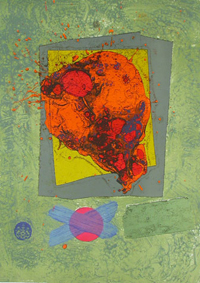
Document 1
A 76 x 56 cm waterless lithography printed on Stongehenge 300 gm paper. The original was produced on a piece of 4 x 5 glass with various transparent plastic materials. Reclaimed plates with Kwik Proof were exposed to one of the negatives used for making diazo wipe-on plates. Toner washes on background were printed over a broken flat made with water soluble masking glues. Printed all colors on my linear offset system in 1996.
A 69 x 48 cm waterless printed by linear offset on Fabriano Rospina paper. Image produced by attaching clear plastics to a larger sheet and scanned to a computer where it was manipulated and printed out on an Epson 3000 inkjet. Scanned image ended up 43 cm wide. Transparency exposed to my own positive plates and printed in 17 colors from 11 recycled plates. Some plates used by subtraction (blinding by silicone) to define areas and produce toner wash textures. Gold interference pigment added to toner wash image at bottom of print. Printed in 2000

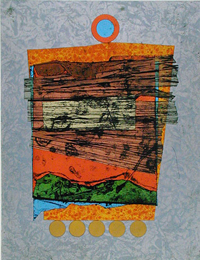
Medal for a Persion Dancer
A 66 x 51 cm waterless lithograph printed in 1994 on Rising Mirage rag paper. Original image made on glass with clear plastic materials and exposed unto HC negatives with and enlarger. The two negatives with different exposures were used on diazo wipe-on plates for black and brown line images. Kwik Proof was exposed by one of the negatives and these plates were used as registration for flats and toner washes. Ten colors were printed from 8 plates.
A 66 x 52 cm waterless lithograph on Daniel Smith Lenox paper, printed in 2005. Clear plastic adhered to Mylar was scanned to obtain an image to manipulate in Photoshop. The transparency from a HP wide format printer was exposed to Dupont positive plate. Flats made with red paper glued to Mylar was exposed to my positive plates. Toner washes on Mylar were transferred to recycled plates to print this 11 color edition from 8 plates. Yellow background plate printed by linear offset.
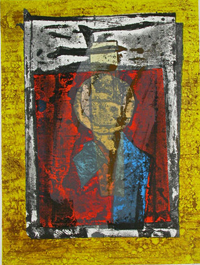
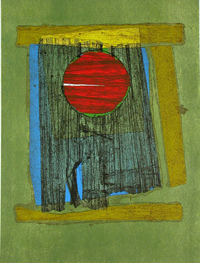
Dispute
A 66 x 51 cm waterless lithograph printed in 9 colors from 9 recycled plates. Image of plastic shapes was scanned and manipulated in the computer, then printed out on a wide format inkjet printer for exposure to my own formulated positive plates. One plate printed by linear offset, the rest by traditional direct transfer of ink to paper. Printed in 2005
The Buffalo Tries to Recall It's Former Glory
A 56 x 38 cm waterless lithograph printed in 17 colors from 14 plates by linear offset on Fabriano Rospina paper. Photograph of a buffalo stone I had taken in the 50’s was scanned into a computer to become part of image. Label was scanned and separated into 3 colors to make up the print. The skull was a drawing directly on a plate with Omnichrom pencil. Modelling of the skull was toner chalk on newsprint and transferred to a plate. Background and foreground plates were toner washes on Mylar with double transfers to plates. Most plates printed by linear offset except for the red on yellow with an outline in the foreground was printed by direct transfer ink to paper. This print is one of six suggested images printed for the one month Asian/North American Collaboration in Hong Kong in 2003.
The buffalo was considered sacred by the natives of
western prairies but was reduced greatly with the coming of the while men. Today it has become a marketing image for a popular beer sold across western Canada
